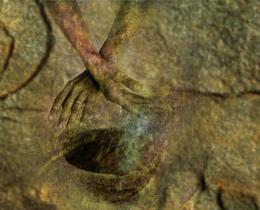We are all carrying grief, a deep unimaginable grief that impacts how we receive and connect with one another. It is a cumulative emotional and spiritual wound that results from the history of violence that we all share. It doesn’t matter if we come from an oppressor population, an oppressed population, or if our ancestors simply witnessed the violence and destruction of oppression, we all carry the imprint of that wound in our souls. This creates a barrier that prevents us from being able to truly see one other, meet one other, and connect with one other.
Trauma is transferred from one generation to the next in very complex ways. The pain that cannot be contained by the first generation is pushed out of the conscious mind and transferred to the next generation through emotional sensitivities, fears, intense sadness, and anxiety disorders. The second-generation recipients of that trauma are often unable to name its source, which causes inexplicable torment and despair.
When the pain of generational trauma rises up in a second- or third-generation recipient, the response can seem extremely disproportionate to the experience at hand. The people around the person suffering may find the intensity of their response hard to comprehend and feel that the person is overreacting. It’s hard for them to understand the depth of the wounding that this person carries.
People faced with this situation will often try to tell the person that it’s not that bad or convince them that they’re blowing things out of proportion. This makes the person feeling the trauma feel flawed, and often leads them to believe that there is something wrong with them, emotionally or psychologically. But, what’s really happening is that they are calling up these old wounds to be healed. What they need is for their trauma to be recognized, accepted, and held gently.
How Trauma Is Passed Through Generations
There are a number of ways for trauma to be passed through the generations. It can be transferred vertically, through oppressive power structures that are connected to the initial wounding, or even through reversals in power, where the oppressed become the oppressor and act out of fear, anger, or a need for vengeance. It can also be transferred horizontally, from one family member to another or to others who are witnessing the trauma of the wounded. A clear example of horizontal trauma is found in the pain of suicide. When someone chooses to take their own life, they don’t end the suffering that they are experiencing; they simply pass that suffering on to all those who remain, who are then forced to carry that pain with them.
Group trauma is passed along in ways that impact the entire group. Group trauma can lead to distorted thinking which often manifests as internalized oppression, as people try to maintain some sense of misplaced control over the circumstances of their oppression. In addition, trauma from long-standing oppression can leave the group huddled together in a form of stagnated solidarity.
When anyone tries to move beyond the place of suffering that the group has occupied they are attacked by the group and brought back down. Some within the group may feel a sense of loyalty to the suffering that the group has endured, and they hold onto it as an act of allegiance. Others attach their identity to the suffering and no longer know who they are beyond its boundaries.
In instances like these, the group has become a place holder for the pain; a living memorial to the trauma that the group has experienced. When the trauma becomes a badge of identity, or a living shrine, it is very difficult for people to consider a new path forward.
The Importance of Acknowledging the Native American Experience
My group, Native Americans, have suffered an unrecognized holocaust in this country. The brutal genocide of Native peoples is hard to acknowledge for many, especially for those who have inherited some value from the loss and destruction that occurred here. How do you acknowledge the injustice of genocide, disruption of culture, and the destruction of a way of life, when you’re living on the lands of those who have been victimized?
It is hard for people to accept that horror and continue to live with the outcome, so they choose to ignore it or minimize the story. The simple truth is that this country was founded on genocide and slavery. This is something that we are all going to have to acknowledge. Until we are able to discuss this honestly there can be no healing.
The first step in the reconciliation process is truth. If we hope to reconcile our path and move forward with any sense of hope, we must begin by telling the truth of our shared history. Unfortunately, our trauma prevents that truth telling. We’re afraid of what might happen when we do. We fear others reactions and we fear our own grief response. But, without this opening there can be no authentic unification between us.



